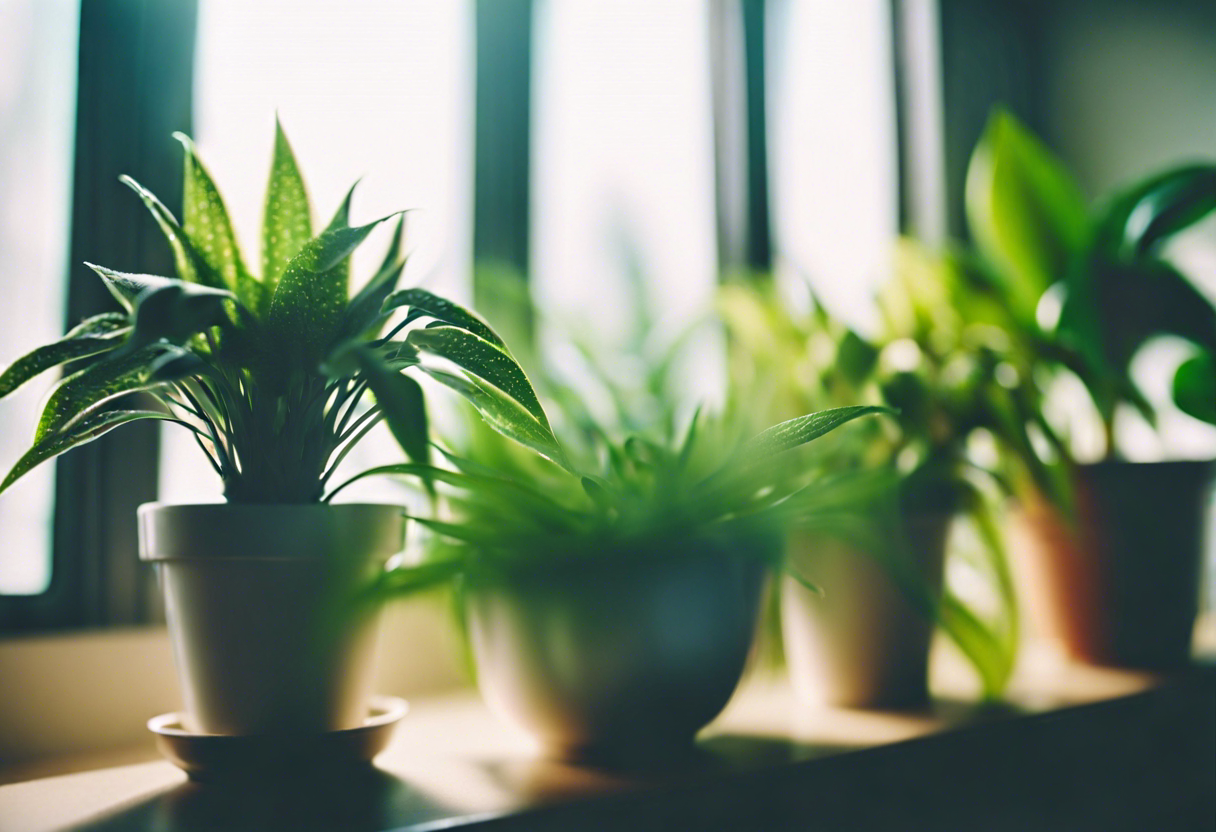The Best Indoor Plants for Clean Air
Having indoor plants not only adds beauty and aesthetic value to your home but also provides several health benefits. One of the key advantages of indoor plants is their ability to purify the air we breathe. If you are looking to improve the air quality in your home, here are some of the best indoor plants for clean air.
1. Snake Plant (Sansevieria trifasciata)
The Snake Plant, also known as Mother-in-Law’s Tongue, is a popular choice for improving indoor air quality. It is highly effective at removing toxins like formaldehyde, benzene, xylene, and trichloroethylene from the air. Additionally, Snake Plants release oxygen at night, making them an ideal choice for bedrooms.
2. Peace Lily (Spathiphyllum wallisii)
The Peace Lily is not only visually appealing but also acts as an excellent air purifier. It helps remove pollutants like benzene, formaldehyde, and trichloroethylene from the air. The Peace Lily is relatively low maintenance and thrives in low light conditions, making it a perfect indoor plant for offices and bedrooms.
3. Spider Plant (Chlorophytum comosum)
The Spider Plant is known for its ability to remove formaldehyde, a common pollutant found in household products, from the air. It is an easy-to-grow plant and can tolerate a wide range of conditions. The Spider Plant also produces oxygen and purifies the air by removing harmful toxins.
4. Aloe Vera (Aloe barbadensis)
Aloe Vera not only has numerous health benefits but also helps purify indoor air. It effectively removes formaldehyde and benzene, commonly found in cleaning products and paints, from the air. Aloe Vera is an attractive plant that requires minimal care and can be easily grown indoors.
5. Boston Fern (Nephrolepis exaltata)
The Boston Fern is a popular choice for improving indoor air quality. It works as a natural humidifier and can help remove toxins like formaldehyde and xylene from the air. The Boston Fern requires a slightly higher level of care compared to other indoor plants, including regular watering and misting.
These are just a few examples of indoor plants that can significantly improve the air quality in your home. these plants into your indoor spaces can help reduce the levels of indoor air pollutants and create a healthier environment for you and your family.
The Benefits of Choosing Indoor Plants for Air Purification
Indoor plants have become increasingly popular not only for their aesthetic appeal but also for their ability to improve air quality. The air inside our homes can sometimes contain pollutants that can negatively impact our health, such as volatile organic compounds (VOCs) and airborne toxins. By incorporating indoor plants into your living space, you can effectively purify and freshen the air you breathe, leading to a healthier and more comfortable environment.
One of the significant benefits of having indoor plants is their ability to remove harmful toxins from the air. Plants naturally absorb carbon dioxide during photosynthesis, but they also have the remarkable ability to absorb other harmful gases as well. Studies have shown that certain indoor plants, such as peace lilies, spider plants, and snake plants, are particularly effective in filtering out pollutants such as benzene, formaldehyde, and trichloroethylene, which are commonly found in household items like paints, cleaning products, and furnishings.
Moreover, indoor plants can also release oxygen and increase humidity levels, creating a healthier living environment. Dry indoor air can lead to various issues, including dry skin, respiratory discomfort, and even headaches. By introducing plants into your home, you can naturally increase moisture levels, making the air more comfortable to breathe and reducing the risk of respiratory problems.
An additional advantage of indoor plants is their ability to improve mental well-being and reduce stress levels. It has been scientifically proven that having plants in our surroundings can lower blood pressure, decrease anxiety, and promote overall relaxation. Their green foliage and vibrant colors have a calming effect on our minds and can help create a more tranquil living space. Studies have also linked indoor plants to increased productivity and concentration, making them a valuable addition to home offices and study areas.
Caring for indoor plants that enhance air quality doesn’t have to be a demanding task. Many of these plants are low-maintenance and require minimal attention. It is important to choose plants that are suitable for your specific living conditions, such as the amount of sunlight and humidity levels in your home. Regularly dusting the leaves, checking for pests, and providing adequate water and nutrition are essential for keeping your indoor plants thriving.
Incorporating indoor plants for air purification offers numerous benefits. Not only can they filter out harmful pollutants and improve air quality, but they can also increase humidity, reduce stress levels, and improve overall well-being. With the wide variety of low-maintenance indoor plants available, anyone can enjoy the advantages of cleaner air and a greener living space.
Top Tips on Caring for Indoor Plants that Improve Air Quality
Indoor plants not only add a touch of greenery to your living space but also play a crucial role in purifying the air. These plants have the ability to remove harmful toxins from the indoor environment, making the air cleaner and healthier. However, in order to maximize their air-filtering capabilities, it is important to provide proper care and maintenance. Here are some top tips on caring for indoor plants that improve air quality:
1. Choose the right plants: When selecting indoor plants for air purification, opt for varieties known for their ability to filter pollutants effectively. Some popular choices include the snake plant, spider plant, peace lily, and pothos. These plants are not only beautiful but also low-maintenance, making them ideal for beginners.
2. Provide adequate light: Most indoor plants thrive in bright, indirect light. Place them near windows where they can receive sufficient sunlight. However, be careful not to expose them to direct sunlight as it can burn their leaves. If natural light is limited in your space, you can supplement it with artificial grow lights specially designed for plants.
3. Water appropriately: Different indoor plants have different water requirements. Before watering, check the moisture level of the soil by sticking your finger about an inch deep into the potting mix. If it feels dry, water the plant thoroughly, allowing excess water to drain out. Be cautious not to overwater as it can lead to root rot and other issues.
4. Maintain proper humidity: Indoor plants generally prefer moderate humidity levels. If the air in your home is too dry, especially during the winter months, consider using a humidifier or placing a tray filled with water near the plants. This will help create a more favorable environment for their growth.
5. Fertilize regularly: Indoor plants rely on regular fertilization for adequate nutrition. Use a balanced liquid fertilizer diluted to half strength and feed your plants once a month during the growing season. Be mindful not to over-fertilize, as this can cause damage to the plants.
6. Monitor pests: Keep an eye out for common indoor plant pests such as aphids, mealybugs, and spider mites. Regularly inspect the leaves, stems, and soil for any signs of infestation. If pests are detected, take immediate action to prevent them from spreading and damaging your plants.
7. Prune and clean: Trim off any dead or yellowing leaves to maintain the overall health and appearance of your indoor plants. Regularly dust the leaves with a soft cloth or sponge to remove dust particles that can hinder their ability to perform photosynthesis.
8. Rotate regularly: Indoor plants tend to grow towards the light source, which can result in uneven growth. To ensure balanced growth, rotate your plants every few weeks so that all sides receive equal exposure to light.
By following these top tips on caring for indoor plants that improve air quality, you can create a healthier living environment while enjoying the beauty and benefits of indoor greenery. With proper care and attention, your indoor plants will thrive and continue to purify the air in your home for years to come.
Choosing Low Maintenance Indoor Plants for Clean Air
If you are looking to improve the air quality in your home or office, incorporating indoor plants is an excellent option. Indoor plants not only add natural beauty to your space but also act as natural air purifiers. They can remove harmful toxins from the air and release clean oxygen, creating a healthier environment for you and your family or colleagues.
When it comes to choosing indoor plants for cleaner air, opting for low maintenance varieties can be a wise decision. Low maintenance plants are perfect for those who are new to gardening or have a busy lifestyle that doesn’t allow for much time spent on plant care. Here are some top tips to consider when selecting low maintenance indoor plants:
Bamboo Palm (Chamaedorea seifrizii)
The Bamboo Palm is an excellent choice for air purification and is easily maintained, making it perfect for beginners. It is known for its ability to remove chemicals like formaldehyde, benzene, and trichloroethylene from the air. Additionally, this palm thrives in low light conditions, making it suitable for various indoor environments.
Snake Plant (Sansevieria trifasciata)
The Snake Plant, also known as Mother-in-Law’s Tongue, is another low maintenance plant that can improve air quality. It is known for its ability to absorb toxins like xylene, toluene, and nitrogen oxides. This plant is extremely resilient and can tolerate a wide range of conditions, including low light and infrequent watering.
Peace Lily (Spathiphyllum)
The Peace Lily is not only aesthetically pleasing but also a powerful air purifier. It can effectively remove harmful substances such as formaldehyde, benzene, and trichloroethylene. This plant thrives in low light conditions and requires minimal watering, making it an excellent choice for those with limited gardening experience.
Dracaena Marginata
The Dracaena Marginata, commonly known as the Dragon Tree, is a low maintenance indoor plant that enhances air quality. It removes pollutants like formaldehyde, benzene, and trichloroethylene from the air. This plant is drought-tolerant and can tolerate low light conditions, making it suitable for various indoor settings.
These are just a few examples of low maintenance indoor plants that can effectively improve air quality. When selecting plants for clean air, it’s essential to consider factors such as light levels, watering needs, and toxicity levels if you have pets or young children. By incorporating low maintenance indoor plants into your space, you can enjoy the benefits of cleaner air without the added stress of complicated plant care.
How Indoor Plants Enhance Indoor Air Quality and Improve Health
Indoor plants are not only a beautiful addition to our living spaces but also play a crucial role in improving indoor air quality. These plants are not just decorative, but they act as natural air purifiers by filtering out harmful pollutants and releasing clean, fresh oxygen. indoor plants into your home or workspace can have numerous benefits for your health and well-being.
One of the key ways indoor plants enhance indoor air quality is through the process of photosynthesis. During photosynthesis, plants absorb carbon dioxide and release oxygen, which helps to improve the air we breathe. This natural process helps to remove harmful toxins and pollutants, such as formaldehyde, benzene, and trichloroethylene, commonly found in indoor environments. By reducing the presence of these substances in the air, indoor plants play an essential role in creating a healthier and more pleasant living or working environment.
Additionally, indoor plants can help to increase humidity levels indoors. Many indoor spaces, especially during the winter months, can become dry and lack the necessary moisture. This can lead to dry skin, irritated eyes, and respiratory issues. By releasing moisture into the air through a process called transpiration, indoor plants can help to create a more comfortable and humid environment, reducing the symptoms of dryness and promoting overall well-being.
Moreover, indoor plants have been shown to improve mental health and overall well-being. Numerous studies have demonstrated the psychological benefits of having plants indoors, including reducing stress, enhancing mood, and increasing productivity. The presence of greenery and nature indoors has a calming effect on our minds and promotes a sense of tranquility and relaxation. This connection to nature can help to reduce anxiety, boost creativity, and improve overall mental health.
When it comes to choosing indoor plants for improving air quality, some species excel in purifying the air. Spider plants, peace lilies, snake plants, and pothos are among the most effective plants at removing toxins from the air. These plants are relatively low-maintenance and can thrive in a variety of indoor conditions. By strategically placing these plants in different areas of your home or office, you can maximize their air purifying benefits.
Incorporating indoor plants into your living or working environment can have significant benefits for indoor air quality and overall well-being. These plants act as natural air purifiers, removing harmful toxins and pollutants from the air, while also increasing humidity levels and promoting a sense of calm and relaxation. By selecting specific plant species known for their air-purifying properties, you can optimize the quality of the air you breathe and enjoy a healthier and more enjoyable indoor space.
Conclusion
Indoor plants for clean air into your living or working space is a practical and aesthetically pleasing way to enhance indoor air quality and improve overall health. The best indoor plants for clean air, such as the snake plant, pothos, and peace lily, have been scientifically proven to remove harmful toxins and release oxygen into the environment, making them an excellent choice for air purification.
The benefits of having indoor plants for air purification are numerous. Not only do these plants effectively filter out pollutants and improve indoor air quality, but they also add beauty and tranquility to any space. Studies have shown that having indoor plants can reduce stress levels and enhance productivity, making them a valuable addition to any home or office.
To ensure that your indoor plants thrive and continue to improve air quality, it is essential to provide proper care. Top tips for caring for indoor plants that improve air quality include watering them adequately, providing sufficient light, and regularly dusting their leaves. It is also crucial to avoid overwatering and to use well-draining soil to prevent root rot and other diseases.
When choosing low maintenance indoor plants for cleaner air, consider factors such as the amount of natural light available and the level of care you are willing to provide. Plants like the spider plant and bamboo palm are known for their ease of care and excellent air purifying qualities. These low maintenance plants can thrive in a variety of indoor environments and require minimal attention.
Indoor plants not only enhance indoor air quality but also greatly contribute to improved health. By removing toxins from the air, such as formaldehyde and benzene, indoor plants reduce the risk of respiratory diseases and allergies. Additionally, plants release moisture into the air, which can help alleviate dry skin and respiratory issues caused by dry indoor environments.
Bringing indoor plants into your living or working space is a simple yet effective way to create a healthier and more aesthetically pleasing environment. By carefully selecting the best indoor plants for air purification, providing proper care, and understanding the benefits they offer, you can enjoy cleaner air, enhanced well-being, and a more vibrant space. So, why wait? Start transforming your indoor environment with indoor plants today and experience the incredible benefits they bring to both your health and surroundings.


